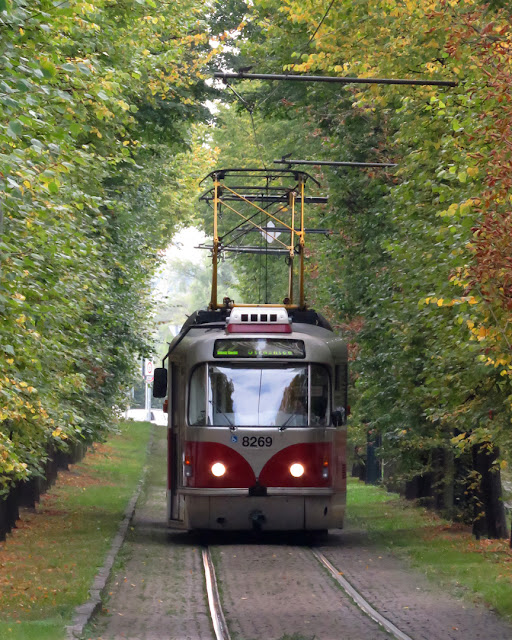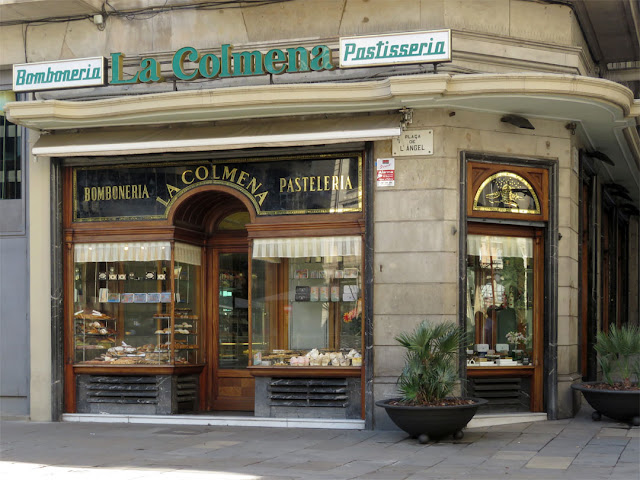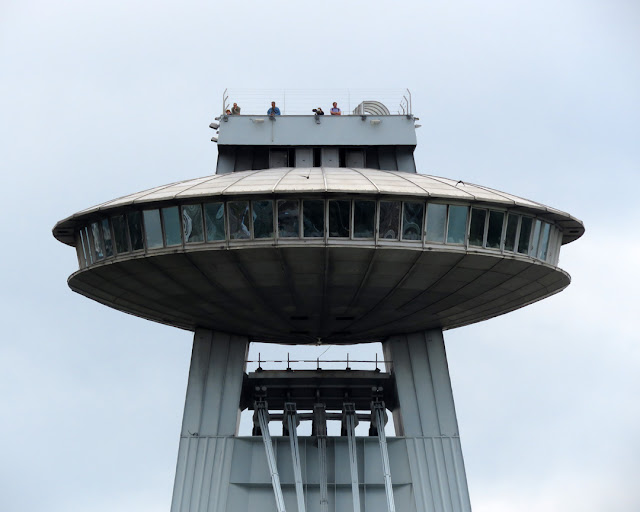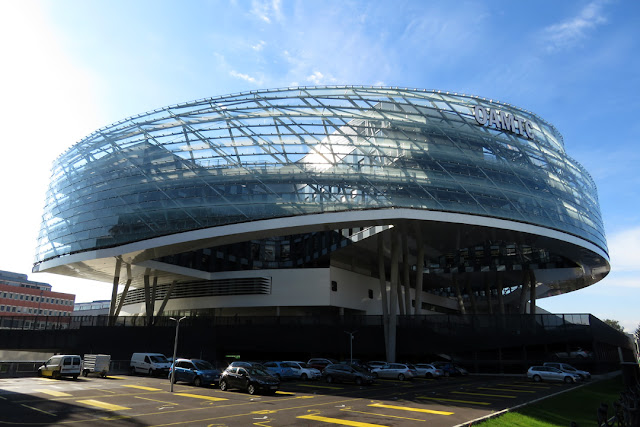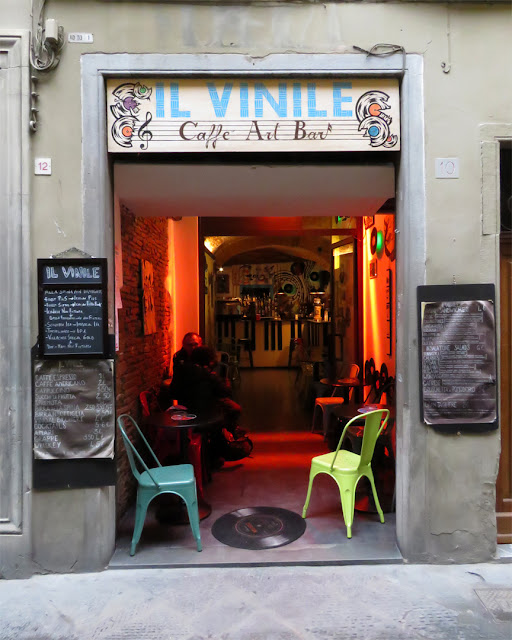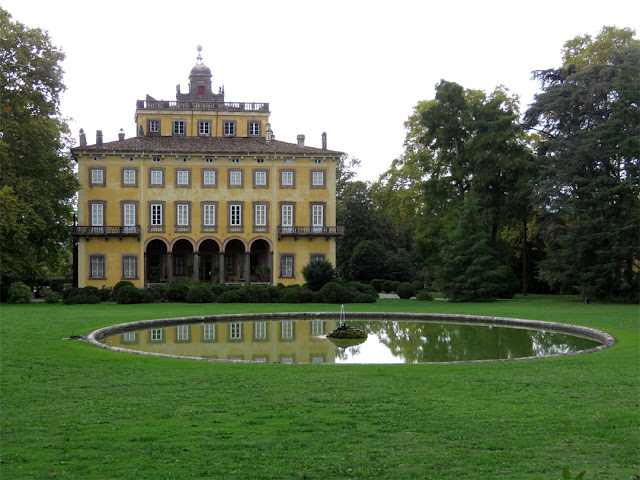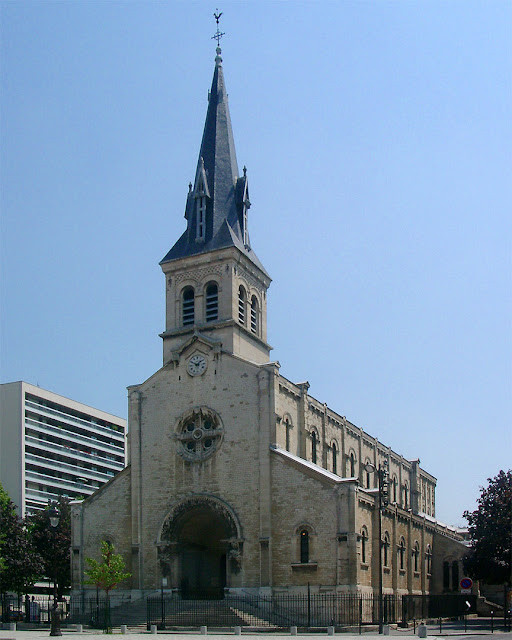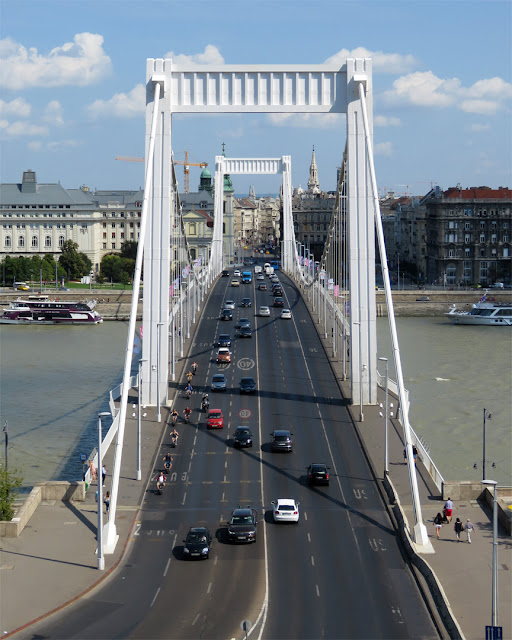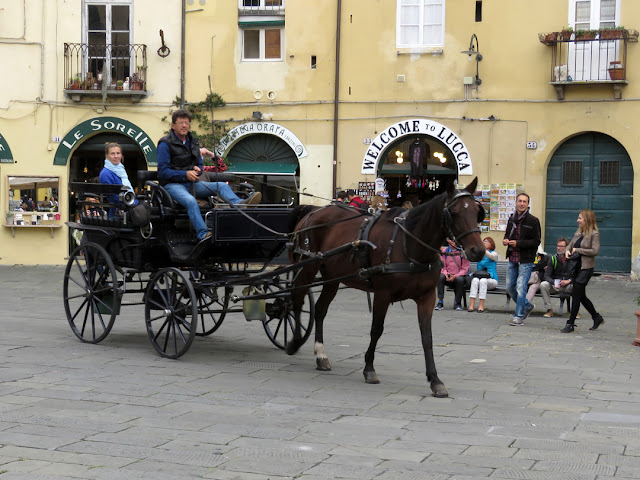Wednesday, January 31, 2018
DomAquarée Galeria
Galeria in the CityQuartier DomAquarée by Tchoban Voss Architekten, 2004
Karl-Liebknecht-Straße
Berlin, September 2011
Tuesday, January 30, 2018
Müllverbrennungsanlage Spittelau
Müllverbrennungsanlage Spittelau (Spittelau incineration plant) by Friedensreich Hundertwasser, 1971
Spittelauer Lände
Vienna, September 2017
“A popular photographic motif in Vienna is the Spittelau waste incineration plant, whose façade was redesigned and given its present colorful, irregular structures by eco-architect Friedensreich Hundertwasser following a major fire in 1989. Since then, the former utility building has combined the topics of waste, energy and art in a fascinating way. On a tour of the plant, visitors get an insight into Vienna's waste, recycling and disposal system, as well as the environmentally friendly generation of thermal heat and hot water.” (In Vienna, energy is also art, Vienna)
Monday, January 29, 2018
House of Serragli
Coats of arms of the House of Serragli
Complesso di San Firenze (Complex of San Firenze)
Piazza San Firenze
Florence, January 2018
Sunday, January 28, 2018
Chester Terrace
Chester Terrace
Regent's Park
Camden
London, January 2007
“Chester Terrace is one of the neo-classical terraces in Regent's Park, London. The terrace has the longest unbroken facade in Regent's Park, of about 280 metres (920 ft). It takes its name from one of the titles of George IV before he became king, Earl of Chester. It now lies within the London Borough of Camden. As with Cornwall Terrace and York Terrace, the architectural plans were made by John Nash but subsequently altered almost beyond recognition by Decimus Burton, who was responsible for the existing design, built by his father James Burton in 1825. Nash was so dissatisfied with Decimus's design that he sought the demolition and complete rebuilding of the Terrace, but in vain. It is a Grade I listed building.” (Chester Terrace, Wikipedia)
Saturday, January 27, 2018
Szabadság híd
Szabadság híd (Liberty Bridge) by Feketeházy János, 1896
Budapest, September 2017
“Szabadság híd (Liberty Bridge or Freedom Bridge) in Budapest, Hungary, connects Buda and Pest across the River Danube. It is the third southernmost public road bridge in Budapest, located at the southern end of the City Centre. It was originally named Ferenc József híd (Franz Joseph Bridge). At its two ends are two public squares, Gellért tér (at the foot of Gellért Hill, with the Gellért Spa and Hotel Gellért) and Fővám tér (with the Great Market Hall). The Liberty Bridge is the shortest bridge in Budapest’s center. Initially built as part of the Millennium World Exhibition at the end of the 19th century, the bridge features art nouveau design, mythological sculptures and the country’s coat of arms adorned on its side. The northeastern house contains a museum on the bridges of Budapest. The bridge was the first in the city to be rebuilt after suffering heavy damage during World War II.” (Liberty Bridge, Wikipedia)
Friday, January 26, 2018
Thursday, January 25, 2018
Maréchal Juin
Monument to Maréchal Juin by André Greck, 1983
Place d'Italie
Quartier de la Maison-Blanche, 13th arrondissement
Paris, July 2010
“After Operation Torch, the invasion of Algeria and Morocco by British and American forces in November 1942, Juin ordered French forces in Tunisia to resist the Germans and the Italians. His great skills were exhibited during the Italian campaign as commander of the French Expeditionary Corps. His expertise in mountain warfare was crucial in breaking the Gustav Line, which had held up the Allied advance for six months.” (Alphonse Juin, Wikipedia)
Wednesday, January 24, 2018
Tram line 22
Tram line 22
Mariánské hradby
Hradčany (Castle District)
Prague, September 2017
“Tram 22 follows one of Prague's most scenic routes with stunning views along the way. It goes from Nadrazi Hostivar on the south-east end of Prague through the hip Vinohrady quarter to the New Town, passing by the National Theatre, crossing the river Vltava to Mala Strana (the Lesser Town) and continuing up to the Prague Castle. It ends at Bila hora on the west suburb of the city. The 22 is ideal to see Prague´s major attractions in a cheap and comfortable way. You can hop on/off and visit the most interesting places in Prague. The tram 22 uses iconic red tram cars T3 built by Tatra between 1960-1999. Several times an hour is the T3 replaced by modern low-floor tram car made by Skoda.” (Tram 22 Prague, Small Charming Hotels)
Tuesday, January 23, 2018
Monday, January 22, 2018
Sunday, January 21, 2018
Most SNP
Most SNP (Bridge of the Slovak National Uprising)
Bratislava, September 2017
“Most SNP (Bridge of the Slovak National Uprising), commonly referred to as Most Slovenského národného povstania or the UFO Bridge, and named Nový most (New Bridge) from 1993 to 2012, is a road bridge over the Danube in Bratislava, the capital of Slovakia. It is the world's longest cable-stayed bridge to have one pylon and one cable-stayed plane. It is an asymmetrical cable-stayed bridge with a main span length of 303 m (994 ft). Its steel construction is suspended from steel cables, connected on the Petržalka side to two pillars. The total length of the bridge is 430.8 m (1,413 ft), its width 21 m (69 ft), and it weighs 537 t (592 short tons). A special attraction is the flying saucer-shaped structure housing a restaurant, which since 2005 has been called UFO (previously, Bystrica), on the bridge's 84.6 m (278 ft) pylon. The restaurant is reached using an elevator located in the east pillar, and offers a good view over Bratislava.” (Most SNP, Wikipedia)
Saturday, January 20, 2018
Chiesa di Ognissanti
Chiesa di Ognissanti (Church of All Saints)
Borgo Ognissanti
Florence, January 2018
“The chiesa di San Salvatore di Ognissanti or more simply chiesa di Ognissanti (Church of All Saints), is a Franciscan church located on the piazza of the same name in central Florence, region of Tuscany, Italy. Founded by the lay order of the Umiliati, the church was dedicated to all the saints and martyrs, known and unknown. It was completed originally during the 1250s, but almost completely rebuilt around 1627 in Baroque-style by the architect Bartolomeo Pettirossi. Soon after, a new façade (1637) was erected using designs by Matteo Nigetti, that conserved the glazed terracotta lunette over the doorway, which while resembling the work of Della Robbia, is now attributed to Benedetto Buglioni. Ognissanti was among the first examples of Baroque architecture to penetrate this Renaissance city. Its three reversed orders of pilasters enclose niches and windows with elaborate cornices. To the left of the façade is a campanile of 13th and 14th century construction.” (Ognissanti, Wikipedia)
Friday, January 19, 2018
Thursday, January 18, 2018
ÖAMTC Headquarters
ÖAMTC Headquarters by Pichler & Traupmann Architects, 2016
Baumgasse
Vienna, September 2017
“The ÖAMTC (Österreichischer Automobil-, Motorrad- und Touringclub/Austrian Automobile, Motorbike and Touring Club) is to build a new headquarters. The goal was to develop a building that consistently takes account of the ÖAMTC’s impressive range of different functions – from member service to helicopter support point – and that also depicts the ÖAMTC business philosophy of transparency and openness.” (ÖAMTC Headquarters, Architizer)
Wednesday, January 17, 2018
Tuesday, January 16, 2018
Galeria Kaufhof Alexanderplatz
Galeria Kaufhof Berlin-Alexanderplatz
Brunnen der Völkerfreundschaft by Walter Womacka, 1970
Alexanderplatz
Berlin, September 2011
Monday, January 15, 2018
Francis II Rákóczi
Statue of Francis II Rákóczi by János Pásztor, 1937
Outside Hungarian Parliament Building
Kossuth Lajos tér (Kossuth Lajos square)
Budapest, September 2017
“Francis II Rákóczi (II. Rákóczi Ferenc, 27 March 1676 – 8 April 1735) was a Hungarian nobleman and leader of the Hungarian uprising against the Habsburgs in 1703-11 as the prince (fejedelem) of the Estates Confederated for Liberty of the Kingdom of Hungary. He was also Prince of Transylvania, an Imperial Prince, and a member of the Order of the Golden Fleece. Today he is considered a national hero in Hungary.” (Francis II Rákóczi, Wikipedia)
Sunday, January 14, 2018
North Facade
North facade of Villa Torrigiani
Camigliano, Capannori
Lucca, October 2017
“The first mention of the villa dates back to 1593, as belonging to the Buonvisi family. It was bought later by Nicola Santini, into whose family it passed. Santini rebuilt the south facade in the Baroque style at the end of the seventeenth century, probably in imitation of the architecture of Versailles where he was ambassador to the Republic of Lucca. The rebuilding involved the addition of two wings to the villa, and the modification of the front by the addition of a massive scale range leading to a serliana, duplicated on the upper floor with two balconies, decorated with statues. He also laid out new gardens. At the front, parterres were arranged around two pools. At the rear, a fountain was built as the focus of the garden, and another sunken ‘garden of Flora’ was laid out to the east. In 1816 Victoria Santini married into the eponymous Torrigiani family, who uprooted the existing garden to make an ‘English style’ park. Only the garden of Flora survived. Now the villa is owned by Fabio Colonna di Stigliano.” (Villa Torrigiani, Wikipedia)
Saturday, January 13, 2018
Friday, January 12, 2018
Napoleonský vojak
Napoleonský vojak (Napoleon's Soldier) by Juraj Meliš, 1997
Hlavné námestie, Staré Mesto
Bratislava, September 2017
“The Napoleonic army entered the city twice. The first time they entered the city, it was in December 1805 when 300 riders and 9000 infantry soldiers marched in the streets. The armistice was signed in the Primate's Palace after the battle of Austerlitz. After that, Napoleon himself entered the city.” (Napoleon's Soldier, Statues - Hither & Thither)
Thursday, January 11, 2018
Bust of Cellini
Bust of Benvenuto Cellini by Raffaello Romanelli, 1901
Ponte Vecchio
Florence, January 2018
“In 1900, to honor and mark the fourth century of the birth of the great Florentine sculptor and master goldsmith Benvenuto Cellini, the leading goldsmiths of the bridge commissioned the Florentine sculptor, Raffaello Romanelli, to create a bronze bust of Cellini to stand atop a fountain in the middle of the Eastern side of the bridge, where it stands to this day.” (Ponte Vecchio, Wikipedia)
Wednesday, January 10, 2018
Notre-Dame-de-la-Gare
Église Notre-Dame-de-la-Gare de Paris by Claude Naissant, 1859
Place Jeanne-d'Arc
Quartier de la Gare, 13th arrondissement
Paris, July 2005
Tuesday, January 9, 2018
Archduke Charles of Austria
Archduke Charles of Austria by Anton Dominik Fernkorn, 1859
Heldenplatz (Heroes' Square)
Vienna, September 2017
“He rediscovered Baroque sculpture and used it as the basis for his equestrian statue of Archduke Charles (1859), who had defeated Napoleon at the Battle of Aspern in 1809. In this work Fernkorn skillfully executed the difficult task of creating a monumentally sized equestrian statue with the horse (and rider) successfully balanced on the horse's two rear legs.” (Anton Dominik Fernkorn, Wikipedia)
Monday, January 8, 2018
Lampredotto
“Lampredotto” food truck
Piazzale Michelangelo
Florence, December 2017
“Lampredotto is a typical Florentine dish, made from the fourth and final stomach of a cow, the abomasum. ‘Lampredotto’ is derived from the Italian word for lamprey eels, lampreda, as the tripe resembles a lamprey in shape and color. A sandwich with lampredotto—panino co i' lampredotto—has been described as a ‘classic Florentine’ sandwich and is a traditional regional street food in Florence. Lampredotto is typically slow-cooked in a vegetable broth, seasoned with herbs, chopped,and served in a bread roll. It is often topped with a spicy sauce or a green sauce (salsa verde). The Daily Meal has called lampredotto ‘a tripe-lover's dream.’” (Lampredotto, Wikipedia)
Sunday, January 7, 2018
Monument to Francesc Macià
Monument to Francesc Macià by Josep Maria Subirachs, 1991
Plaça de Catalunya
Barcelona, March 2017
“Francesc Macià i Llussà was the first President of the Generalitat de Catalunya and held office from 1932 until his death in 1933. Born in September 1859, Macià grew up in Vilanova i la Geltrú (a medium sized town approximately 50 kilometres south of Barcelona). After a spell in the Spanish army, he fought for Catalan independence and formed the political party Estat Català which later merged with other pro-independence groups to form Esquerra Republicana de Catalunya (Republican Left Wing of Catalonia). In 1931 the ERC won local elections and proclaimed the Catalan Republic. Three days later the Catalan Republic was restructured as the Generalitat de Catalunya (Government of the autonomous region of Catalonia) with Francesc Macia as president and the statute was drawn up. This unusual monument is the work of Josep Maria Subirachs and was inaugurated in 1991. The mostly abstract statue consists of a bronze bust of Macià in front of an inverted concrete staircase. The unfinished staircase symbolises the ongoing history of Catalonia which is being constructed day-by-day.” (Monument to Francesc Macià, Barcelona Lowdown)
Saturday, January 6, 2018
Erzsébet híd
Erzsébet híd (Elisabeth Bridge), 1964
Seen from Gellért-hegy (Gellért Hill)
Budapest, September 2017
“Elisabeth Bridge (Erzsébet híd) is the third newest bridge of Budapest, Hungary, connecting Buda and Pest across the River Danube. The bridge is situated at the narrowest part of the Danube in the Budapest area, spanning only 290 m. It is named after Elisabeth of Bavaria, a popular queen and empress of Austria-Hungary, who was assassinated in 1898. Today, her large bronze statue sits by the bridge's Buda side connection in the middle of a small garden.” (Elisabeth Bridge, Wikipedia)
Friday, January 5, 2018
Thursday, January 4, 2018
For a Cleaner Thames
“Working together for a cleaner Thames”
Seen from the Queen's Walk
Southwark
London, January 2008
“River workers in 1937 would have been perplexed by the corporate-style sloganeering carried in the words ‘working together for a cleaner Thames’ that adorn the floating ‘rubbish muncher’ of 2008.” (The transformation of the Thames riverbank, Financial Times)
Wednesday, January 3, 2018
Rotunda of Saint Martin
Rotunda sv. Martina (Rotunda of Saint Martin), 11th century
K Rotundě, Vyšehrad
Prague, September 2017
“The rotunda of St Martin is the largest and oldest preserved rotunda in Prague. It was built in the second half of the 11th century. It has escaped demolition several times in its history. During the Thirty Years’ War it was used as a gunpowder store. The cannonball embedded in the façade to the right of the window is a reminder of the Prussian rampage in 1757. The rotunda is now used for religious purposes by the Vyšehrad ecclesiastical chapter.” (Rotunda of St Martin , Prague.eu)
Tuesday, January 2, 2018
Monday, January 1, 2018
Berlin Schönefeld Airport
Berlin Schönefeld Airport
Schönefeld
Berlin, September 2011
“Berlin Schönefeld Airport (Flughafen Berlin-Schönefeld) (formerly IATA: SXF, ICAO: EDDB, ETBS) was the secondary international airport of Berlin, the capital of Germany. It was located 18 km (11 mi) southeast of Berlin near the town of Schönefeld in the state of Brandenburg and bordered Berlin's southern boundary. It was the smaller of the two airports in Berlin, after Berlin Tegel Airport, and served as a base for easyJet and Ryanair. In 2017, the airport handled 12.9 million passengers by serving mainly European metropolitan and leisure destinations. In the same year, the travel portal eDreams ranked Berlin Schönefeld as the worst airport in the world after evaluating 65,000 airport reviews. Schönefeld Airport also was the major civil airport of East Germany (GDR) and the only airport of the former East Berlin. On 25 October 2020 the Schönefeld name and IATA code ceased to exist, marking its closure as an independent airport, with large parts of its infrastructure being incorporated into the new Berlin Brandenburg Airport (IATA: BER, ICAO: EDDB) as its Terminal 5 with its sections renamed to K, L, M and Q.” (Berlin Schönefeld Airport, Wikipedia)
Subscribe to:
Posts (Atom)








